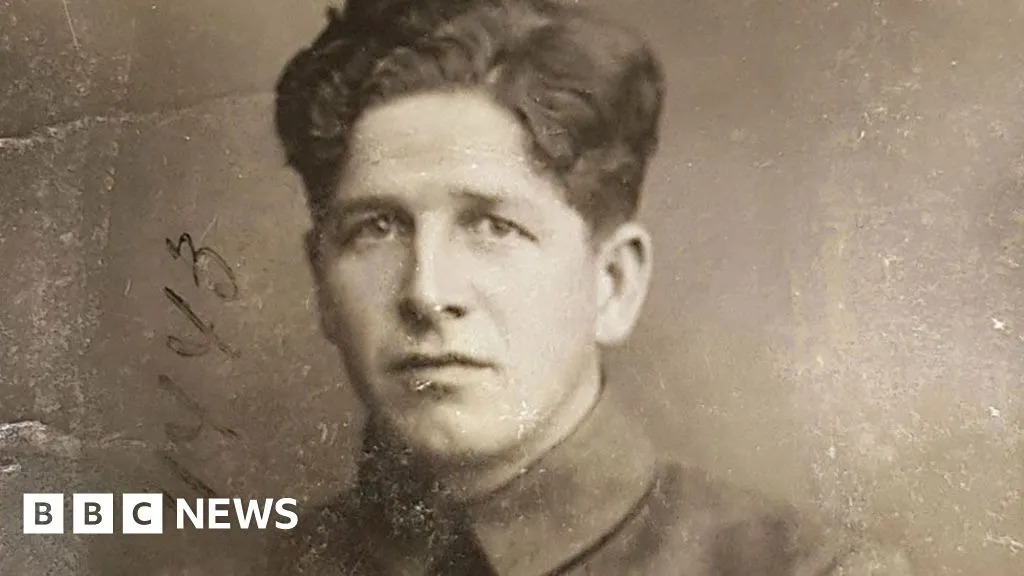On a remote mountain side in Norway is a memorial which remembers a World War Two RAF pilot and a daring escape.
It is dedicated to Wilfred Surplice, 30, station commander of RAF Rivenhall, Essex, who sacrificed himself in November 1944 so his crew could bail out.
Four of the crew made it back to Britain thanks to Norwegian resistance workers like Espen Thronsen's grandfather, Einar.
Mr Thronsen, 53, from Skien in southern Norway, says it is important to remember "a story about people helping others, knowing that they can be killed".
They risked their lives to rescue Allied forces because "the English wanted to help the Norwegians in their fight against the Germans", he explained.
Mr Thronsen's grandfather Einar Thronsen joined the resistance as a wireless operator in 1940, soon after German troops invaded neutral Norway.
He worked for NRK - the national public radio station - which meant he had German papers allowing him to freely travel around the Skien area.
"By 1944, he had become the boss of the wireless operation in the area," said Mr Thronsen.
The SOE (Special Operations Executive) arms and equipment resupply mission took off from Rivenhall, near Chelmsford, on 2 November.
As the Stirling neared its drop zone, it was struggling to cope in the bitter cold and thick snow showers.
Wing Cdr Surplice ordered the six men aboard to bail out and the icebound plane smashed into the mountain.
Mr Thronsen said: "Sqn Ldr Kenneth Bolton, Pilot Officer Robert Chapin and Warrant Officer Robert Dalton landed in a snowstorm and got together almost at once and were soon joined by Lt Michael Hicks, the SOE liaison officer at Rivenhall [who had also been on the plane].
"The evaders wandered around for a couple of days in the wilderness until they found a cottage, put a fire on and someone from the resistance found them."
The other two survivors were not so lucky; they were captured and imprisoned by the Germans.
For the better part of two months, the four men were taken on night time marches, boat trips, car journeys - and left in remote huts for days at a time as the Norwegian resistance organised their repatriation.
Other key people instrumental in the British men evading capture included Alex Prydz, Jens Anton Paulsson (one of the heroes of Telemark, who helped stop the German atomic bomb), Lillen Dahll Vogt and Liv Schodt.
Mr Thronsen's grandfather was put in charge of the escape from 16 November, driving a wood-burning car, commandeering a taxi and using horse-drawn sledges, to continue their journey south to Bamble, on the Norwegian coast.
"On about 22 November, they were given to another party of resistance workers who shipped them out to a small island," he said.
They had to flee their camp after the Germans located it, killing two Norwegians.
"Then they were stuck for almost a month as they waited for a boat to take them to Sweden."
The first rescue boat was forced to turn back due to the appalling weather conditions.
"But the second attempt was successful, they made it to Sweden and on 2 January, they were flown to Scotland," he said.
Just a few days later, Einar, his wife and little daughter fled the country on the same boat.
Mr Thronsen said: "The Germans were finding out who had helped [the resistance] so they needed to get away, because if the Gestapo got hold of them, my grandfather would have been tortured and given up names and they didn't dare stay for that."
The family did not return to Norway until after Victory in Europe was declared in May 1945.
Chris Bullock lives near RAF Rivenhall station and has been researching its wartime history for more than 10 years.
"Wing Cdr Surplice was station commander when 295 and 570 squadrons moved there and helped settle them in after they'd spent an horrific 10 days during Operation Market Garden (September 1944), so he was a great loss," said Mr Bullock.
From October, the squadrons were tasked with flying solo missions, dropping SOE and SAS supplies into France, the Netherlands and Denmark, as well as Norway.
"What's struck me is there are lots of people in the Netherlands and in Norway who want to tell the story of the RAF air crews and ground troops that were part of their liberation," said Mr Bullock, who recently hosted a Norwegian couple who were also familiar with the crash site, for a tour of Rivenhall.
Einar only talked about his wartime experiences if he was asked, said Mr Thronsen.
He began to research his grandfather's wartime career while doing military service aged about 19 or 20, and later inherited the post-war letters he received from British airmen, including from Sqn Ldr Bolton.
"They wanted to help him after the war; Norway was very poor; so they sent him chocolates for his daughter and told him how much they appreciated his help," he said.
Wing Cdr Surplice was buried in Oslo War Cemetery but in 1982, a memorial was erected in his memory at the crash site in Skardfjell.
"I usually visit the wreck site of Surplice's Stirling once or twice a year; it's a three or four hour hike from Kalhovd," said Mr Thronsen.
"I like stories of people doing extraordinary things and these people knew they could be shot and killed and yet, still they helped others."
